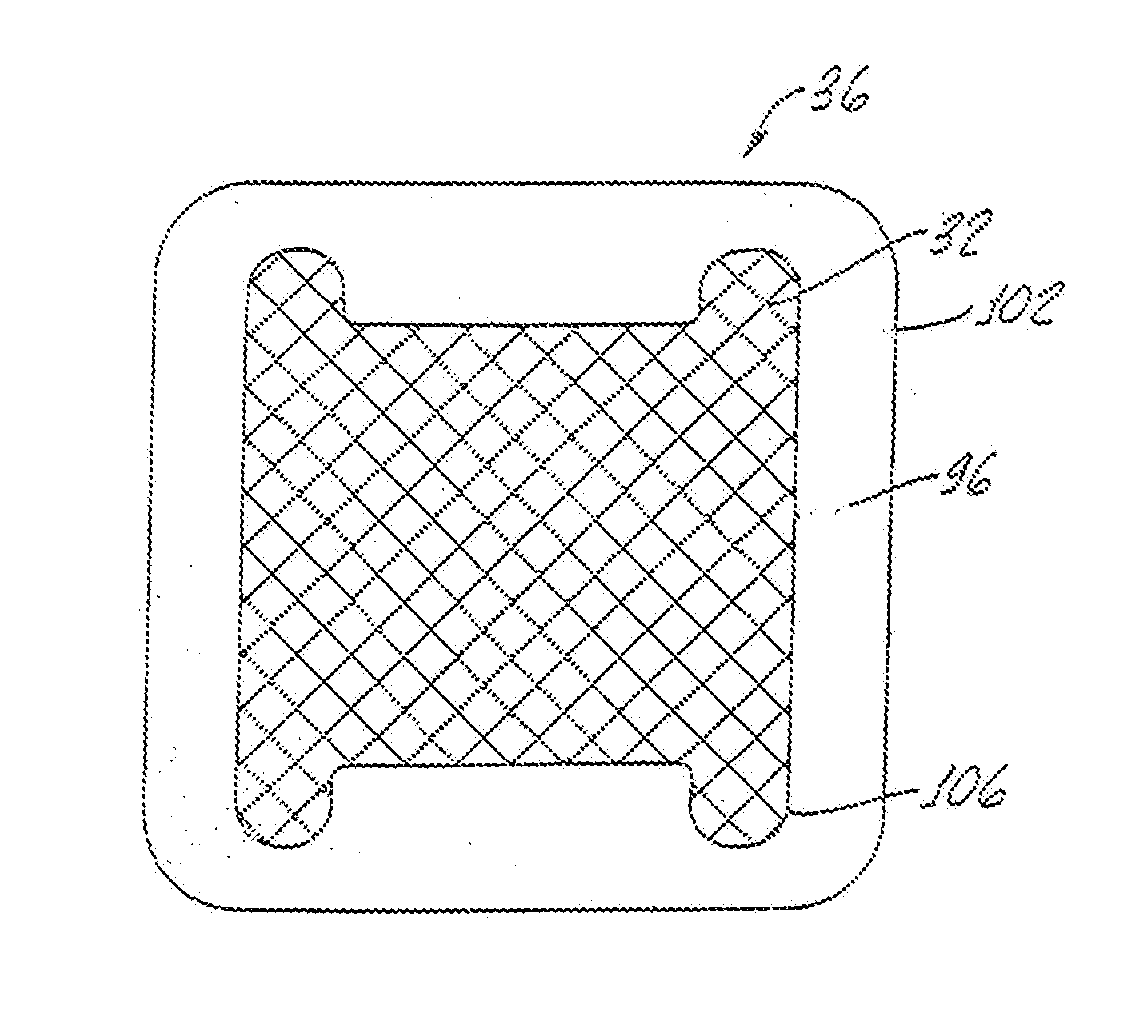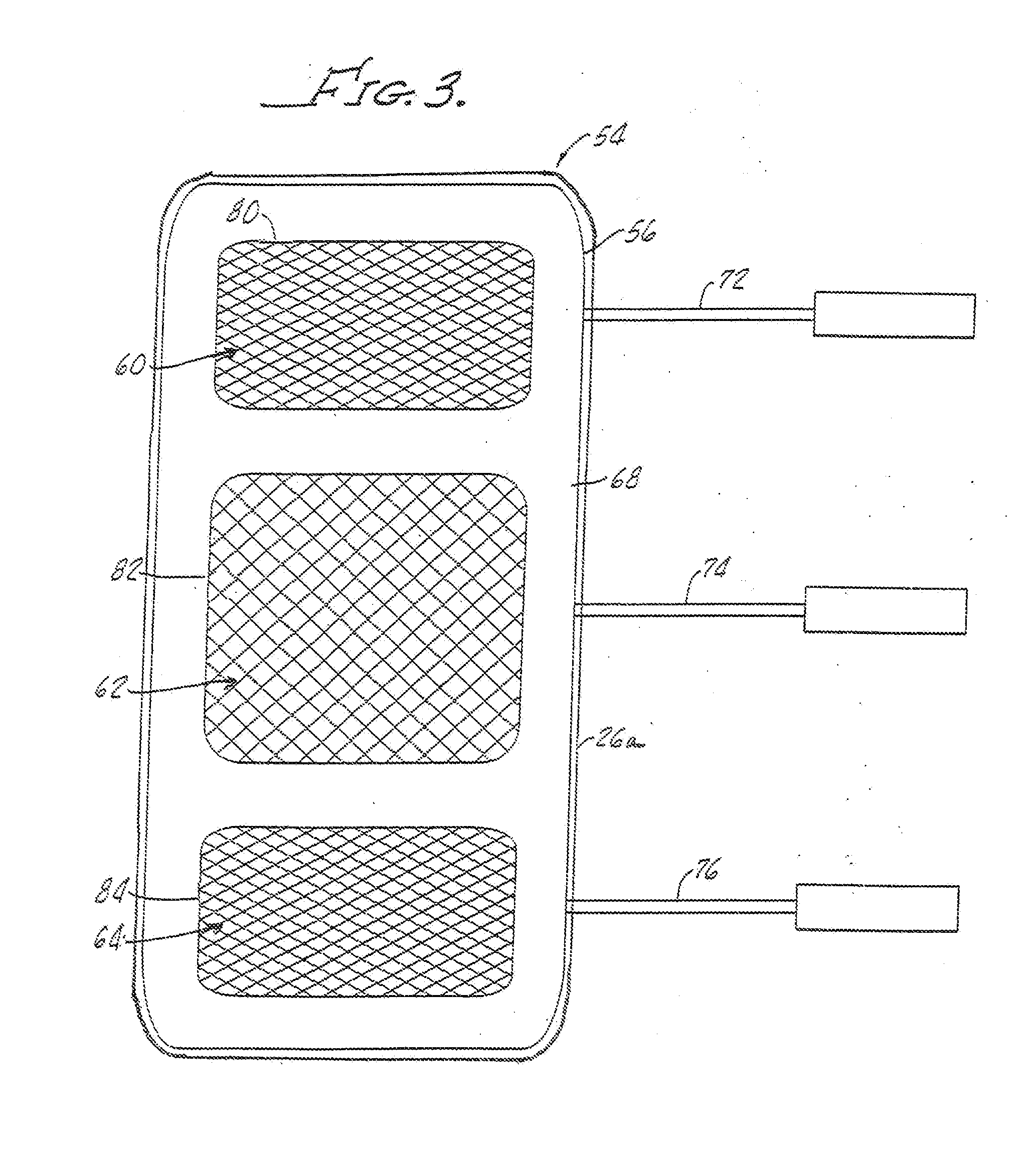Multi-electrode with lateral conductivity control
- Summary
- Abstract
- Description
- Claims
- Application Information
AI Technical Summary
Benefits of technology
Problems solved by technology
Method used
Image
Examples
embodiment 54
[0043] Shown in FIG. 3 is another electrode embodiment 54 which includes a moderately conductive flexible member 56 having a plurality of highly conductive ink patterns 60, 62, 64 disposed on a bottom side 68 of the conductive member 56. The conductive ink patterns 60, 62 and 64 may be of various shapes and grid patterns in order to customize the electrical conductivity of the electrode 54 beneath the pattern 60, 62, 64. The adhesive, not shown in FIG. 3, is of moderately high conductivity as hereinabove described.
embodiment 10
[0044] The spaced apart patterns 60, 62 and 64 act as separate electrodes and communicate with lead wires, or connectors, 72, 74, 76 respectively, which are attached to a top side (not shown in FIG. 3) of the conductive member 56 as illustrated in FIG. 1 with the description of the electrode embodiment 10.
[0045] The advantage of utilizing a common conductive member 56 with spaced apart ink patterns 60, 62, 64 is that this structure provides uniformity of spacing between the independent electrodes. This in effect provides a template to insure proper electrode placement on a patient's skin.
[0046] It should be appreciated that, as shown in FIG. 3, the connector 72, 74, 76 are in placed over the ink patterns 60, 62, 64. The lead wires 72, 74, 76 may be placed anywhere between the borders 80, 82, 84 of the ink patterns 60, 62, 64 since the current distribution across the electrode gel adhesive 44 is independently controlled as hereinabove noted.
[0047] Referring to FIGS. 2a and 2b, the ...
embodiment 120
[0055] In this embodiment 120, a moderately conductive flexible member 122 includes a top 124 and a bottom 126 with a plurality of highly conductive patterns 130, 132 disposed on the bottom side 126 of the conductive member 122. As hereinabove noted, the conductive patterns 130, 132 may be formed from conductive ink.
[0056] Lateral conductivity between the electrode patterns 130, 132 is controlled by a cutout 140 in a conductive adhesive layer 142 and / or a cutout 144 in the conductive flexible member 122. The cutouts also provide for improved flexibility and conformability of the embodiment 120. Lateral conductivity may also be controlled by varying a thickness of the conductive flexible member and / or conductive adhesive. In that regard, the thickness may not be uniform with variation in thickness used to control lateral conductivity.
[0057] A similar cutout 150 is shown in FIG. 8 in an embodiment 152, similar to the embodiment 54 shown in FIG. 3 with identical or substantially simil...
PUM
 Login to View More
Login to View More Abstract
Description
Claims
Application Information
 Login to View More
Login to View More - R&D
- Intellectual Property
- Life Sciences
- Materials
- Tech Scout
- Unparalleled Data Quality
- Higher Quality Content
- 60% Fewer Hallucinations
Browse by: Latest US Patents, China's latest patents, Technical Efficacy Thesaurus, Application Domain, Technology Topic, Popular Technical Reports.
© 2025 PatSnap. All rights reserved.Legal|Privacy policy|Modern Slavery Act Transparency Statement|Sitemap|About US| Contact US: help@patsnap.com



